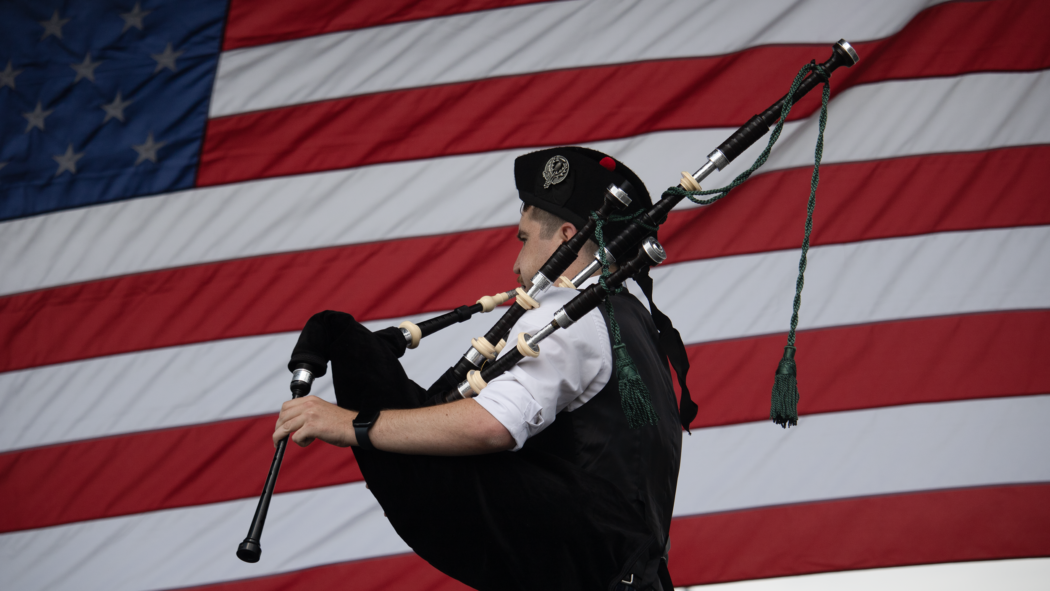North Logan never forgets
The Major Brent Taylor Foundation hosted an exhibit called The 9/11 Project in North Logan to commemorate the events of Sept. 11, 2001. The exhibit lasted four days and was hosted in the Hansen Family Sports Complex.
Inside the complex was a walk-through exhibit detailing the before and after of 9/11. Attendees found themselves going through a New York subway tunnel and on the streets of Manhattan.
Outside of the complex were fire trucks, helicopters and a stage for speakers.
Hector Soto, a former employee of the New York Transit Authority, was a speaker at the event and sat down for an interview with The Utah Statesman beforehand.
Hailing from a family of New York’s finest, Soto now lives in Utah but remains true to his New York roots through his native accent and 9/11 remembrance work.
“I come from a family of cops, so there was four of us in my family who served,” Soto said. “Two of us got cancer, and between the two of us, I’m the only one still alive.”
Soto worked a six-to-six overnight shift with New York City Transit and had finished a shift a few hours before the first plane hit the North Tower at 8:46 a.m.
Soto found himself in New Jersey that day but immediately clocked in for work later that evening.
“The island of Manhattan was shut down. Nobody in, nobody out, because they thought there were still terrorists on the island that they didn’t want to get out. So the island was completely shut down. It took me about four and a half hours on a normal 90-minute commute,” Soto said.
When the towers fell, they immediately destroyed the subway tunnels running underneath them. The 1 Train, also known as the Broadway Local to Soto, was destroyed. Being a member of the transit authority, Soto was sent to work underground before the fire department and police were.
“We’re more qualified than police and fire to be able to go down on the track since they’re electrified, and so a lot of times we assisted them and worked alongside them,” Soto said.
Soto had several friends and family pass after 9/11 due to related illnesses.
“After 9/11, on the event that we do here, everybody goes about their daily lives, but there are still people that live 9/11 every day that’s suffering some type of pulmonary disease or some type of cancer,” Soto said.
According to BBC, 6,781 9/11-illness-related deaths have occurred since 9/11.
USUSA President Matt Richey made a solo appearance at the exhibit on Sept. 12 to play “Amazing Grace” and a few other songs on the bagpipes. He explained that the bagpipes are often a patriotic instrument.
“‘Amazing Grace,’ particularly on the bagpipes — it’s really emotional for a lot of people,” Richey said.
The community event also housed booths with pieces from the buildings, flags dedicated to 9/11 and other historical memorabilia.
Other notable moments of the exhibit included the presence of the American Red Cross, poetry readings and singers.
Soto spoke multiple times throughout the exhibit, telling his 9/11 story and talking about life thereafter. He would only get emotional talking about his friend Eddie Lee.
Lee worked alongside Soto at the New York Transit Authority, but his wife worked in the towers and passed on 9/11.
“They never found her. He was away from work for two to three months going to different hospitals, trying to find her,” Soto said.
Lee was a bit older than Soto, who saw him as a role model throughout the years. The pair worked together for 30 years, including on 9/11. Lee later died of cancer he got from working on Ground Zero.
“He lost his life. Man, that was — it was pretty emotional. Man, he lost his life to lung cancer, and the guy never smoked, believe it or not,” Soto said.
Soto’s jacket and hard hat that he wore on Ground Zero are being installed this month in the national 9/11 museum.
“I’ll leave you with this —I tell this all the time. You don’t realize how much stuff we take for granted in life. And so when you think about 3,000 people went about their daily lives not knowing that that day was going to be the last day here, I always tell people, ‘Listen before you walk out your front door, you make sure you validate the people you love because you never know if that would be the last day you ever come back through that door,’” Soto said.

